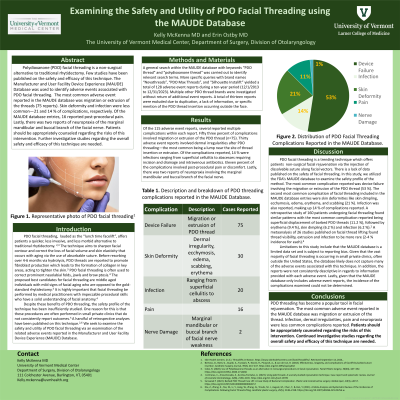Facial Plastic and Reconstructive Surgery
(0515) Examining the Safety and Utility of Polydioxanone Facial Threading Using the MAUDE Database
Monday, September 30, 2024
12:00 PM - 1:00 PM EDT

Has Audio
Disclosure(s):
Kelly A. McKenna, MD: No relevant relationships to disclose.
Introduction: Polydioxanone (PDO) threading has been implemented in facial rejuvenation as a non-surgical alternative to traditional rhytidectomy. Few studies have been published regarding the safety and effectiveness of this technique. The Manufacturer and User Facility Device Experience (MAUDE) database was used to identify adverse events associated with this technique.
Methods: A general search within the MAUDE database with keywords “PDO thread” and “polydioxanone thread" was carried out to identify relevant search terms. More specific queries with brand names “Novathreads”, “PDO Max Threads”, and “Silhouette Instalift” yielded a total of 128 adverse event reports during a ten-year period (December 1, 2013 to December 31, 2023). Multiple other PDO thread brands were investigated without return of additional event reports. 13 reports were excluded due to duplication, a lack of information, or specific mention of the PDO thread insertion occurring outside the face.
Results: Of the 118 adverse event reports, all of which occurred within the past 7 years, 64% (n = 75) involved migration or extrusion of the PDO thread. 16.9 % of patients (n = 20) represented in the reports developed associated infections ranging from superficial cellulitis to more extensive infections requiring intravenous antibiotics and abscess incision and drainage. 31 adverse event reports (26.3 %) involved dermal irregularities after PDO threading—the most common being a lump near the site of thread insertion or extrusion. Adverse event reports (16) involved postprocedural pain or discomfort. Lastly, there were 2 reports of neuropraxia involving the marginal mandibular and buccal branch of the facial nerve.
Conclusions: PDO threading has become a popular tool in facial rejuvenation. The most common adverse event reported in the MAUDE database was migration or extrusion of the thread. Infection, dermal irregularities and pain were less common complications reported. Patients should be appropriately counseled regarding the risks of this intervention. Further investigative studies regarding the overall safety and efficacy of this technique are needed.

Kelly A. McKenna, MD
Resident Physician
University of Vermont
Burlington, Vermont, United States- EO
Erin Ostby, MD
University of Vermont Medical Center
Burlington, Vermont, United States
